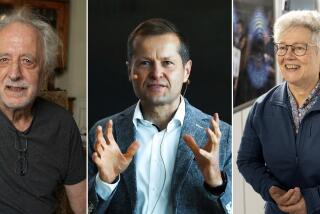Georges Charpak dies at 86; French physicist won Nobel Prize
- Share via
French physicist Georges Charpak, who revolutionized the study of elementary particles by developing detectors that allowed near-instantaneous identification and analysis of particles produced in accelerator collisions, a feat that won him the 1992 Nobel Prize in physics, died Sept. 29 in Paris. He was 86.
His death was announced by the French research ministry, but no cause was given.
His work enabled the discovery of many different charged particles and led to physics Nobels for several researchers who used the detector in their own experiments.
“If you were to remove everything Charpak invented from all the particle detectors at all the big accelerator laboratories, you would simply not have anything left,” John Peoples Jr., then-director of the Fermi National Accelerator Laboratory in Illinois, said at the time Charpak received the Nobel.
The discoveries of the elementary particles known as W and Z at a European laboratory and the charm quark at the Stanford Linear Accelerator Laboratory “would not have been possible without his detectors, and most current research in high-energy physics depends on these devices,” Peoples said.
Accelerators slam elementary particles, ions and atoms together at very high energies. Under the right conditions, the collisions produce rare and exotic particles that last for only the tiniest fractions of seconds. Researchers often must sort through millions of tracks to find one or two examples of the particles they seek.
The first detectors used cloud chambers, which were filled with supercooled, supersaturated water or alcohol vapor. As charged particles or atoms produced by the collisions passed through the vapor, they left behind a trail not unlike the contrails produced by a jet airplane at high altitude. The trails were photographed and laboriously analyzed to search for unusual tracks that indicated the presence of a new particle.
Later, researchers used bubble chambers filled with a superheated liquid. Again, charged particles left behind a trail that was photographed and analyzed. Both the cloud chamber and the bubble chamber won their inventors Nobels, but the devices became impractical as higher-energy collisions produced ever larger numbers of tracks to be analyzed.
Charpak attacked the problem by adapting the Geiger Muller tube, which is the heart of the well-known Geiger counter for measuring radiation. The tube consists of a thin wire in a gas-filled tube. A high-voltage difference is established between the wire and the wall of the tube. When a charged particle passes through the gas, it ionizes the gas, freeing electrons that move to the wire and create an electrical signal.
The Geiger Muller tube can tell when a particle passes through but can say little about its position and direction. Charpak produced what he called multiwire proportional chambers, in which a series of thin wires in parallel roles were suspended between two flat cathodes. Layering many of these chambers and attaching the output of each wire electrode directly to a computer made it possible to determine the track of each particle precisely in real time. Moreover, the device could track hundreds of thousands of particles every second.
Virtually all the detectors now in use represent some variant of this original design, first published in 1968.
Georges Charpak was born Aug. 1, 1924, in Dabrovica, which was then in Poland but is now part of Ukraine. His family moved to France when he was 5 to escape religious persecution. During World War II, the family refused to wear the yellow star identifying them as Jewish and obtained identification papers under the name Charpentier. Georges joined the French resistance at 15 and was ultimately arrested by the Vichy government in 1943 and imprisoned.
A year later, at age 19, he was deported to the Dachau concentration camp, from which he was liberated at the end of the war. In 1946, he became a naturalized French citizen. He received an undergraduate degree in civil engineering from the Ecole des Mines and a doctorate in nuclear physics from the College de France, both in Paris.
As he did his graduate work with Nobel laureate Frederic Joliot-Curie, he began building the equipment he needed to conduct his experiments, which was the only way for researchers to obtain the devices they need to carry out their work. He was invited to join the Centre Europeen pour la Recherche Nucleaire, the large accelerator laboratory commonly known as CERN, in Geneva and spent his entire career there.
At CERN, he established the SOS Committee to aid persecuted and minority scientists. In 1984, the group offered to trade places with Yelena Bonner, wife of dissident Soviet physicist Andrei Sakharov, and serve as hostages while she sought medical treatment in the West, but the offer was turned down.
In later years, Charpak adapted the detector for use in medicine, biology and industry. He wrote several books, including “Debunked” (2004) with Henri Broch, in which they sharply criticized such reputed supernatural phenomena as telekinesis and ESP.
Information about survivors could not be confirmed. Charpak married Dominique Vidal in 1953, and the couple had two sons, Yves and Serge, and a daughter, Nathalie.
More to Read
Start your day right
Sign up for Essential California for the L.A. Times biggest news, features and recommendations in your inbox six days a week.
You may occasionally receive promotional content from the Los Angeles Times.




